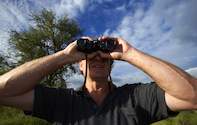
Most people have no difficulty seeing objects in their home environment where they are, possibly sub-consciously, assisted by familiar movements, position, colour, sounds, gait, style etc. We get used to seeing things in certain places at certain times. The difficulty often arises in an unfamiliar environment - such as game reserves. An inability to 'spot' things can result from unfamiliar surroundings or because of a poor understanding of how Vision operates.
If we are in a room full of people and other objects and the lights suddenly go out, we 'see' nothing. We may believe that all is still there, through experience or sound but we would not actually 'see' anything. When the Light comes on again we can 'see' the same things and any changes that have taken place.
Remember that we do not see Objects (as such). What we 'see' is Light - either reflected or direct from objects and are also aware of the contrasting shadows caused by objects blocking the light. The shadows vary in density with reduced to no light. True darkness is total lack of any light. This is why God is referred to as the Light of the World - bringing vision and hope in a world of darkness where we might not be able to see too clearly.
Take a sheet of paper or use your flat hand and turn it at varying angles to see the change in 'colour' or shade of the same object in relation to the source of light. The same applies to animals as they move around - they may change from dark to light with varying contrast.
White light, as we all will know, is a combination of all the colours of the spectrum from ultra violet to infra red, as seen by human beings in the refraction of light through raindrops in a rainbow. Certain types of animals see only parts of the spectrum that we see or even parts that are not available to the human eye. Animal eyesight is normally quite different to that of human beings.
Very generally, all mammals see monochrome or 'black and white' (apart from the primates and certain other specialised eyes that see a spectrum similar to ours) - while egg-laying animals (birds, reptiles, insects etc) can see colour - although different to that seen by human beings. The fact that mammals see black and white and egglaying animals see colour has a very marked effect on behaviour patterns and colouring.
You will understand why many animals are light coloured underneath (in the shadow area) and darker on top, so that they present less contrast to the sight of a predator. Behaviour is most interesting but I will deal with that aspect in another article. Apart from the mammals seeing monochrome, they generally also see a much more 'blurred' image than that of human beings, while birds, at least, see a much sharper image than human beings.
This is caused by the varying density in the make up of the retina at the back of the eye. If one takes a magnifying glass to a newspaper image the pixels or printed 'spots' making up the picture will become obvious. Lift the glass to magnify the paper and you will notice that movement is also magnified.
Lower the glass and notice that as the picture becomes clearer the lateral movement diminishes. Mammals generally see a more blurred picture than humans but can spot movement more easily than we can. So to a mammal remaining still is a very important part of camouflage. Birds, which see more clearly than we do, may not be able to identify slight movement and so they very frequently move their heads from side to side in order to detect distance and contrast in depth of field.
This is one reason why, when you remain still, mammals may come up very close, with ears open and 'noses' raised, to try and smell or hear what you are - or circle down wind to try and catch your scent. It doesn't really matter what clothing you wear as long as it is not very dark or very light coloured - although it might make you look 'macho' to other humans.
Movement is much more significant. If you make disturbing movements or noise most animals with tend to move away, hide or remain hidden. When trying to spot animals bear in mind temperature and wind direction as that will greatly affect where animals are to be found and their activity at certain times of the day.
In likely spots, remember that contrast will depend on light intensity. Some animals are well camouflaged when in front of a similar coloured background while others will hide obvious parts of their body behind other objects. Camouflage and concealment are two different behavioural activities.
The things to look for - as often taught in the military - are shape, shadow, shine, silhouette, spacing, signs etc in suitable habitat. Watch the behaviour of visible animals that might give you some indication of the whereabouts of other animals. Remember what you look like to the animals you are observing and try to behave appropriately so that you don't disturb their activities - or the experience of other people near to you.
Dave Rushworth

 This Kruger Park photography guide suggests the best locations and routes for photography in Kruger Park. Enjoy a photo safari and take amaz...
This Kruger Park photography guide suggests the best locations and routes for photography in Kruger Park. Enjoy a photo safari and take amaz...